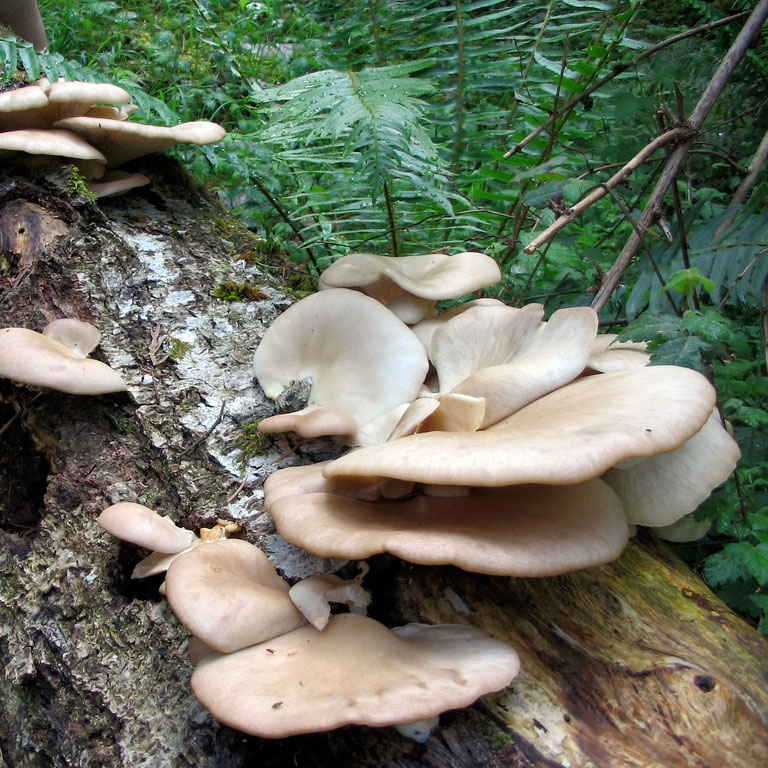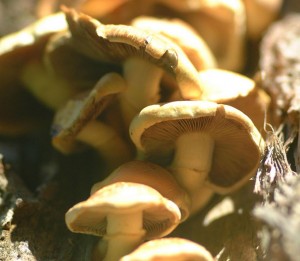Mushroom: “Let them eat wood”
What does a grapple-boom excavator, a termite, and a person enjoying a plate of ginger-shiitake chicken stir fry have in common? They all eat wood. Sort of. At least if you go along with my rather broad definition of eating.
A grapple boom has a powerful hydraulic pincer that reduces wood-frame structures to splinters, usually with permission from their respective owners, by chewing through them from the top down. The houses, that is, not the owners.
Unlike carpenter ants, which merely tunnel through decaying wood to make nests, termites actually ingest perfectly sound wood. Technically it is the microbial community in their gut which digest the cellulose and release byproducts that termites depend on. No termite could survive on a diet of wood without its internal “farm” of microorganisms.

Wild oyster mushrooms growing on a decaying log. Photo: Jeanette S., Creative Commons, some rights reserved
And from studio apartments to five-star restaurants, people the world over consume all manner of delectable dishes featuring second-hand wood. Although that is not generally how it is worded on the menu. Mushrooms such as inky cap, oyster, and shiitake have a voracious appetite for wood, a substance that very few organisms eat because it is so hard to digest, as anyone who has tried to eat a two-by-four can attest.
Wood is made primarily of cellulose along with varying amounts of lignin. This latter compound is to cellulose what steel reinforcing rod is to concrete. There is far less of it but it imparts a great deal of strength and resilience. Even professional wood-eating bacteria in the gut of a termite can’t digest lignin. Only certain fungi have that superpower.
There are three basic groups of wood-decaying fungi: soft-rot, brown-rot and white-rot. In scientific terms these coteries are not closely related even though they have the same last name. (Apparently for fungi, “rot” is like our “Smith” in that respect.)

Wild shiitake mushrooms growing on a tree. Photo: Mike, Creative Commons, some rights reserved
Soft-rot fungi are very common and cause garden-variety decay in tomato stakes and fence posts. Wooden ones, at least. Brown rot is less common. At some time or other you’ve probably seen its handiwork. This fungus creates a blocky pattern and turns wood into miniature, spongy brown bricks. Although brown rot needs moisture to do its dirty work, it is sometimes called dry rot because it readily dries out and is often seen in that condition.
Both soft-rot and brown-rot fungi consume only cellulose and “eat around” lignin.
White-rot fungi, on the other hand, belong to the clean plate club, digesting every component of wood. This category of fungi can cause serious decay in hardwood trees, although a few species attack conifers. Foresters hate it, but foodies love it. It is the group that gives us Armillaria mellea, a virulent and devastating pathogen that produces tasty honey mushrooms.
Shiitake and oyster mushrooms are white-rot fungi, although they are saprophytes, akin to scavengers like turkey vultures, not predator-like pathogens. So we don’t have to feel guilty about eating them. Regionally, shiitake farming has, um, mushroomed over the past decade. It is a source of supplemental income for farmers and a source of fun and good food for anyone who wants to try it.

Cultivating shiitake mushrooms. Marijke introduces mushroom spores into a drilled log. Photo: George Cook, Saranac Lake, NY
Somewhat fickle, shiitake prefer oak, beech, maple, and ironwood, more or less in that order. To cultivate this mushroom, you would cut logs, or bolts, of one of these hardwoods. Bolts are typically about four feet long and range from three to eight inches in diameter. A log will bear mushrooms for roughly one year per diameter inch. A series of holes are drilled in the logs, and these are filled with mushroom “seeds” called spawn. Oyster mushrooms are more laid back, and will grow on less-valuable material such as poplar, or even on a damp roll of toilet paper. They also can be “seeded” between stacked blocks of wood which makes it easier to get them started.
Nearly all historians agree Marie Antoinette probably never said “Let them eat cake,” a saying already in popular culture of the time. The phrase was ascribed to her by opponents to bolster her reputation as callous and arrogant. She would have seemed far more benevolent if she had said “Let them eat wood.”
More information on mushroom farming, or call your local Cornell Cooperative Extension office.
Paul Hetzler is a horticulture and natural resources educator with Cornell Cooperative Extension of St. Lawrence County.
Tags: agriculture, food, mushrooms





.jpg)

